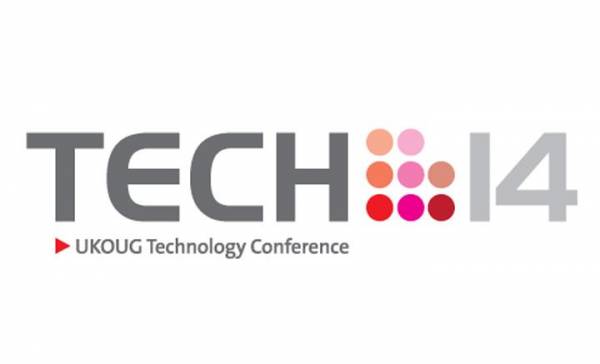
Today I went to UKOUG 2014 at Liverpool. In this blog, you’ll find the sessions on Oracle WebLogic, Fusion Middleware, SOA Suite, and EDG I attended and a little resumé about it.
Administration of SOA Suite – A few tips
Jon Petter Hjulstad (SYSCO Middleware)Jon Petter’s general advice was to make the monitoring stronger. You have to be pro-active in your administration of SOA Suite. You have several tools for monitoring SOA such as FMW Control, Enterprise Manager 12c or even JMC. You may want to check CPUs, memory usage and Disk space as usual but don’t forget to look at database growth and logs.
His advice is to look at patches as soon as they are releases as it will repair leaks and security issues but it will also tune up the whole system and its components.
Strongly use RDA support, it can brings a lot of information for creating Service Requests and it will hardly reduce the “ping pong” between your organization and the support team.
Fusion Middleware 12c Installation and Administration: First Experiences
Peter de Vall and Nicolay Moot (Transfer Solutions)Both are from Transfer Solutions Company from Netherland. They talked about the differences of installing and managing Fusion Middleware 11g and 12c. The benefits of using 12c is that it is clearly more integrated than the 11g version. Moreover when installing for Devs it packages for an easy to use version. This way, developers don’t have to borrow a heavy installation architecture.
Another difference is the homes path. When in 11g you had Middleware Home, Oracle Common Home, Oracle Product Home and RCU Home, here in 12c you only have Oracle Home.
Same thing for the configuration part. In 11g you had Domain Homes, Instance Homes and Node Manager Home, here you have only Domain Homes as you have one node per Domain.
Upgrading is really easy to handle as 12c provides some scripts for the upgrade. It manages the upgrade of domains and configuration in less than an hour.
It upgrades schemas, configurations and domains you just have to provide it the old (11g) domains path then the new (12c) domains path; which can be the same as demonstrated in their demo! And no redeployments or application adaptations to make, developers don’t even have to participate.
A new feature in FM 12c is RESTful. It provides urls that can be monitored by an external tool as it pushes json table which contain metrics information as memory usage and jvm utilization. Really interesting.
Best practices to manage and deliver oracle weblogic and fusion middleware to your organization
James Kao (Oracle)James is a really good speaker, managing to keep you intensively focused on his speech. He was talking about how to manage huge infrastructure with lot of domains. Talking about how many admin console you have to manage, how many configurations you have to perform before your whole environment is setup, when you have for example DEV/TEST/VAL and production environments. It could become hell out there! As it is time consuming and when upgrading or patching it is hard to automate tasks.
James’s answer is “Cloud”.
The goal is to make it available through a single point of access and make it globally administrable in one place.
“Use Cloud Control as a single administration console” he said. As you can manage your configurations and actions on a single place to specific domains or all at the same time. It provides more “templatized” administration through frameworks and it standardize ressources.
Here‘s his best practices:
#1 – Cloud Control as a single admin console
As said before, administration and configuration are integrated to Cloud Control. A system allows to enter your credentials once. When updating a configuration you lock it hence nobody can edit it during the time you are working on it. It can prevent issues when an error is reported and almost 20 administrator are trying to access the system to debug it!
Cloud Control can record every actions you do when editing or administrating. That means you can verify what you did for audit purpose or simply transform it into a WLST script to make it repeatable.
Cloud Control centralizes SOA tracing and stores metrics for history.
#2 – Automates tasks across domains
You can automate tasks by creating WLST scripts thanks to your records. For example you can start recording your session, then edit some values and stop the recording. You create a script from it and execute it on multiple domain!
#3 – Automate responses to issues vie corrective actions
And the best is that the scripts you wrote can be triggered by events from the system. You can create incident rules and specify the actions that would be triggered, all over the domains.
Enterprise Deployments: The real world of best practices
Simon Haslam (Veriton) and Jacco Landlust (Oracle)Simon and Jacco where here to talk about EDG: Enterprise Deployment Guides. These guides are a result from the historical MAA: Maximum Availability Architecture. So, EDG is a kind of guide on how to build your architecture to make it reusable and efficient but there is a difference between “paper” and reality.
EDG benefits:
– You don’t have to know every products by heart
– It’s based on Oracle experience
– It’s familiar to other Admins using EDG (a kind of OFA)
– It’s recognized by Oracle Support!
First EDG covers the following topics:
– Topologies and segregations
– Naming conventions
– It only focuses on single site high availability with load balancers
– Database HA (in RAC)
EDG is a layered step by step builder recipe.
– Layering each stage
– Assumes manually installation (No scripts)
The real world problems for EDG:
– It doesn’t including security thoughts
– It doesn’t include patching thoughts
– It doesn’t include dev/test thoughts (you have to build it by yourself)
– It’s not covering Disaster Recovery
![Thumbnail [60x60]](https://www.dbi-services.com/blog/wp-content/uploads/2022/05/Middleware-TO_Final-wpcf_173x250.png)
![Thumbnail [90x90]](https://www.dbi-services.com/blog/wp-content/uploads/2022/08/OLS_web-min-scaled.jpg)